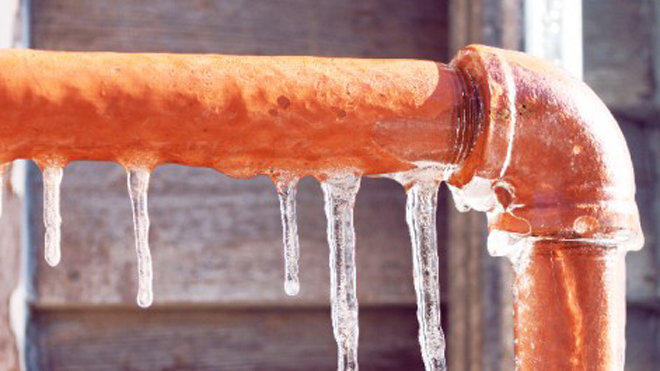Advice for Avoiding Frozen Plumbing in Cold Weather: Specialist Insights
Advice for Avoiding Frozen Plumbing in Cold Weather: Specialist Insights
Blog Article
The publisher is making several good points related to How To Avoid Freezing Pipes as a whole in this post which follows.

Winter can wreak havoc on your plumbing, specifically by freezing pipes. Right here's exactly how to prevent it from occurring and what to do if it does.
Introduction
As temperatures drop, the risk of frozen pipes increases, potentially resulting in costly fixings and water damages. Understanding how to avoid frozen pipes is critical for homeowners in cold climates.
Understanding Icy Pipelines
What causes pipelines to freeze?
Pipelines freeze when exposed to temperature levels listed below 32 ° F (0 ° C) for extended durations. As water inside the pipelines freezes, it broadens, taxing the pipe wall surfaces and possibly triggering them to break.
Risks and damages
Icy pipelines can result in water disruptions, property damage, and expensive repair services. Ruptured pipelines can flooding homes and create considerable architectural damages.
Indicators of Frozen Piping
Recognizing icy pipelines early can avoid them from rupturing.
How to identify icy pipelines
Search for reduced water circulation from taps, uncommon odors or sounds from pipelines, and noticeable frost on revealed pipes.
Prevention Tips
Insulating at risk pipelines
Cover pipes in insulation sleeves or make use of warmth tape to shield them from freezing temperature levels. Focus on pipelines in unheated or external areas of the home.
Home heating strategies
Keep indoor spaces properly warmed, especially areas with pipes. Open up cabinet doors to enable cozy air to flow around pipelines under sinks.
Protecting Outdoor Pipes
Yard hose pipes and outdoor faucets
Detach and drain pipes garden tubes prior to winter season. Install frost-proof faucets or cover outside taps with insulated caps.
What to Do If Your Pipes Freeze
Immediate actions to take
If you think frozen pipelines, maintain faucets open to soothe pressure as the ice melts. Utilize a hairdryer or towels taken in hot water to thaw pipes slowly.
Long-Term Solutions
Structural modifications
Take into consideration rerouting pipes far from outside wall surfaces or unheated areas. Include additional insulation to attic rooms, basements, and crawl spaces.
Updating insulation
Purchase premium insulation for pipes, attics, and walls. Correct insulation helps keep consistent temperature levels and reduces the danger of icy pipelines.
Verdict
Preventing frozen pipes needs aggressive measures and quick reactions. By comprehending the reasons, signs, and preventive measures, property owners can safeguard their plumbing throughout winter.
5 Ways to Prevent Frozen Pipes
Drain Outdoor Faucets and Disconnect Hoses
First, close the shut-off valve that controls the flow of water in the pipe to your outdoor faucet. Then, head outside to disconnect and drain your hose and open the outdoor faucet to allow the water to completely drain out of the line. Turn off the faucet when done. Finally, head back to the shut-off valve and drain the remaining water inside the pipe into a bucket or container. Additionally, if you have a home irrigation system, you should consider hiring an expert to clear the system of water each year.
Insulate Pipes
One of the best and most cost-effective methods for preventing frozen water pipes is to wrap your pipes with insulation. This is especially important for areas in your home that aren’t exposed to heat, such as an attic. We suggest using foam sleeves, which can typically be found at your local hardware store.
Keep Heat Running at 65
Your pipes are located inside your walls, and the temperature there is much colder than the rest of the house. To prevent your pipes from freezing, The Insurance Information Institute suggests that you keep your home heated to at least 65 degrees, even when traveling. You may want to invest in smart devices that can keep an eye on the temperature in your home while you’re away.
Leave Water Dripping
Moving water — even a small trickle — can prevent ice from forming inside your pipes. When freezing temps are imminent, start a drip of water from all faucets that serve exposed pipes. Leaving a few faucets running will also help relieve pressure inside the pipes and help prevent a rupture if the water inside freezes.
Open Cupboard Doors
Warm your kitchen and bathroom pipes by opening cupboards and vanities. You should also leave your interior doors ajar to help warm air circulate evenly throughout your home.

I am just very fascinated with 6 Ways to Prevent Frozen Pipes and I'm hoping you appreciated the entry. Please take the opportunity to promote this blog entry if you enjoyed reading it. Thanks for being here. Kindly stop by our blog back soon.
Call Today Report this page